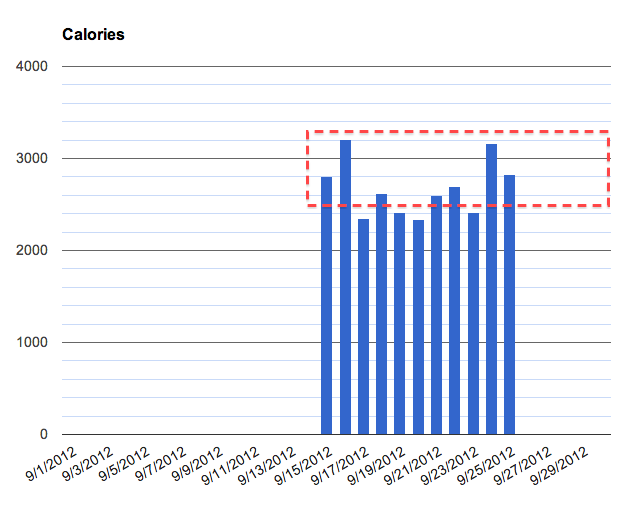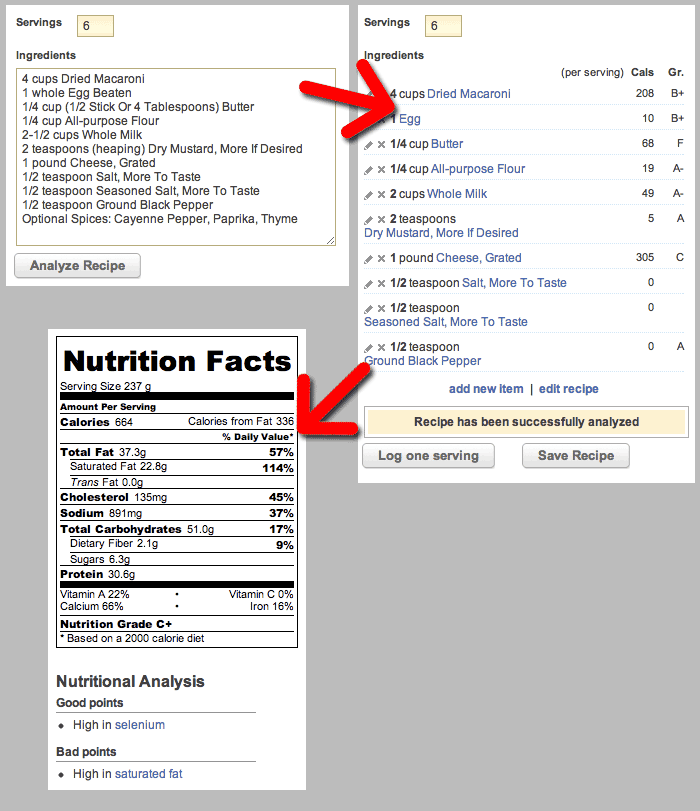
- Weight: 127.4 lbs.
- No workout today
- Total inches: 118.6
- Protein: 127 g (7 g over target)
- Calories: 2,824
I have never worked so hard to put things in my mouth. Hmm, that didn’t come out right …
In starting calorie counts 10 days ago, I’ve had to calculate twice as much before when just counting protein. But I have found two ways to make the chore more bearable.
1. Show it. As much as I love numbers, a visual component helps me a lot. With protein, my spreadsheet cell lights up green once I hit the minimum for the day. (Nerd alert!)
The first few days of calorie tracking, I winged it. I knew my basic maintenance requirement for my age and my size was around 1,700 to 2,000 calories a day. My gut (ha!) tells me I probably used to hit the low end of that figure (ha!) when eating normally.
As my weight gain stalled, I looked at the calories and saw they were inconsistent. I made a chart and realized I should shoot for 2,500 to 3,000 a day to put on pounds.

Chart: Calories through Sept. 25.
Note the target zone of at least 2,500 a day.
Easy enough: Make sure the blue line hits at least 2,500 by day’s end.
2. Use an online recipe calorie calculator. Calories are an imperfect science. An approximation is what you get, but it’s still better than flying blind.
This wonderful calorie calculator allows me to copy and paste recipe ingredients and generate an official-looking nutrition facts label.
For example, I’m making the Pioneer Woman’s excellent macaroni and cheese this week. But instead of looking up the data for each ingredient, I can do it much more quickly with this tool.

Paste in the ingredients, tweak them for analysis
and receive your nutrition facts chart.
Tip: Food bloggers, include nutritional info with your recipes. Bonus points if you style it so it looks like the official label but uses text instead of an image, as I did above.
I can spend less time crunching numbers and more time crunching nuts. Still didn’t come out right …
•
Macaroni and Cheese
from the Pioneer Woman
- 4 cups dried macaroni
- 1 whole egg beaten
- 1/4 cup butter
- 1/4 cup all-purpose flour
- 2-1/2 cups whole milk
- 2 teaspoons (heaping) dry mustard, more if desired
- 1 pound cheese, grated
- 1/2 teaspoon salt, more to taste
- 1/2 teaspoon seasoned salt, more to taste
- 1/2 teaspoon ground black pepper
- (optional) Cayenne pepper, paprika, thyme
Preheat oven to 350 degrees.
Cook macaroni until very firm. Macaroni should be too firm to eat right out of the pot. Drain.
In a small bowl, beat egg.
In a large pot, melt butter and sprinkle in flour. Whisk together over medium-low heat. Cook mixture for 5 minutes, whisking constantly. Don’t let it burn.
Pour in milk, add mustard, and whisk until smooth. Cook for 5 minutes until very thick. Reduce heat to low.
Take 1/4 cup of the sauce and slowly pour it into beaten egg, whisking constantly to avoid cooking eggs. Whisk together till smooth.
Pour egg mixture into sauce, whisking constantly. Stir until smooth.
Add in cheese and stir to melt.
Add salt and pepper. Taste sauce and add more salt and seasoned salt as needed! Do not under-salt.
Pour in drained, cooked macaroni and stir to combine.
Serve immediately (very creamy) or pour into a buttered baking dish, top with extra cheese, and bake for 20 to 25 minutes or until bubbly and golden on top.
Wade’s tip: I like to make this spicy, so I use pepper jack and extra sharp cheddar, along with generous amounts of paprika and cayenne spices. Also, be sure to read The Pioneer Woman’s post and admire her step-by-step photos.





